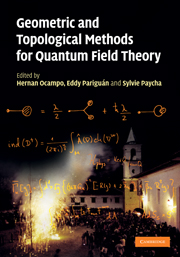Book contents
- Frontmatter
- Contents
- List of contributors
- Introduction
- 1 The impact of QFT on low-dimensional topology
- 2 Differential equations aspects of quantum cohomology
- 3 Index theory and groupoids
- 4 Renormalization Hopf algebras and combinatorial groups
- 5 BRS invariance for massive boson fields
- 6 Large-N field theories and geometry
- 7 Functional renormalization group equations, asymptotic safety, and quantum Einstein gravity
- 8 When is a differentiable manifold the boundary of an orbifold?
- 9 Canonical group quantization, rotation generators, and quantum indistinguishability
- 10 Conserved currents in Kähler manifolds
- 11 A symmetrized canonical determinant on odd-class pseudodifferential operators
- 12 Some remarks about cosymplectic metrics on maximal flag manifolds
- 13 Heisenberg modules over real multiplication noncommutative tori and related algebraic structures
10 - Conserved currents in Kähler manifolds
Published online by Cambridge University Press: 07 September 2010
- Frontmatter
- Contents
- List of contributors
- Introduction
- 1 The impact of QFT on low-dimensional topology
- 2 Differential equations aspects of quantum cohomology
- 3 Index theory and groupoids
- 4 Renormalization Hopf algebras and combinatorial groups
- 5 BRS invariance for massive boson fields
- 6 Large-N field theories and geometry
- 7 Functional renormalization group equations, asymptotic safety, and quantum Einstein gravity
- 8 When is a differentiable manifold the boundary of an orbifold?
- 9 Canonical group quantization, rotation generators, and quantum indistinguishability
- 10 Conserved currents in Kähler manifolds
- 11 A symmetrized canonical determinant on odd-class pseudodifferential operators
- 12 Some remarks about cosymplectic metrics on maximal flag manifolds
- 13 Heisenberg modules over real multiplication noncommutative tori and related algebraic structures
Summary
Abstract
We revisit some properties of Lie algebroids, Lie bialgebroids and bidifferential calculi, in order to stress the relation of the Lie algebroid structure with the constructions of hierarchies of conserved currents and show the existence of a particular class of conserved currents. We give some examples related to Kähler and generalized Kähler structures.
Introduction
In a recent paper [1] Dimakis and Müller-Hoissen showed how to generate conservations laws in completely integrable systems by making use of a bidifferential calculus. More recently, Crampin et al. proved that the approach of Dimakis and Müller-Hoissen was related to the standard approach using bi-Hamiltonian structures of the Poisson–Nijenhuis type [2]. These results were extended in [3], where the Poisson–Nijenhuis case was discussed in a detailed way. Some interesting remarks on the so-called gauged bidifferential calculus by Dimakis and Müller- Hoissen were also given. A detailed description of geometrical properties and a generalization to Lie algebroids were given respectively in [4, 5]. Apart from the previous citations, one can find of interest the relation of the bidifferential calculi and the non-Noether symmetries (see, e.g., [6, 7]), and the application of the bidifferential calculi and Lie algebroids to specific integrable systems (see, e.g., [8, 9]).
As was pointed out in [10], the concepts of recursion operator and hierarchies of conservation laws are related to the Lenard chains, and also the algebraic action of the Nijenhuis operator is related to the Poisson–Nijenhuis structure.
- Type
- Chapter
- Information
- Geometric and Topological Methods for Quantum Field Theory , pp. 368 - 380Publisher: Cambridge University PressPrint publication year: 2010
- 1
- Cited by



